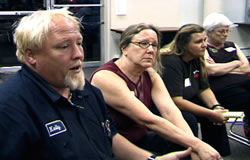 Members of the community near the CSF Buxmont Trevose school have a circle meeting to share their feelings about neighborhood vandalism and brainstorm ideas to remedy the problem.When ongoing vandalism by local youth — graffiti, broken windows, littering — affected Buxmont Academy Trevose and the surrounding neighborhood of families and shop owners, school coordinator Ed Krajewski decided to apply a restorative approach used at the school, one of eight alternative schools operated by the Community Service Foundation and Buxmont Academy (CSF Buxmont) in Pennsylvania, USA (demonstration programs of the IIRP).
Members of the community near the CSF Buxmont Trevose school have a circle meeting to share their feelings about neighborhood vandalism and brainstorm ideas to remedy the problem.When ongoing vandalism by local youth — graffiti, broken windows, littering — affected Buxmont Academy Trevose and the surrounding neighborhood of families and shop owners, school coordinator Ed Krajewski decided to apply a restorative approach used at the school, one of eight alternative schools operated by the Community Service Foundation and Buxmont Academy (CSF Buxmont) in Pennsylvania, USA (demonstration programs of the IIRP).
“I had been spending more and more time dealing with this issue,” said Krajewski. Added Pam Thompson, Krajewski’s colleague and assistant director of CSF Buxmont’s Day Treatment Program, “Neighbors and businesses were being harassed, but they weren’t communicating with each other. People were living in fear, not calling the police. Something had to be done.”
So Krajewski facilitated a restorative talking circle on behalf of the neighborhood. “The circle process is empowering,” said Thompson. “It creates a safe space to share ideas in a meaningful way.”
Among restorative practices, the circle is key. Within the restorative milieu of CSF Buxmont programs, circles are used to foster communication, assist conflict resolution and promote better understanding. The circle is also an essential feature of family group decision making and restorative conferencing.
Neighbors, business owners, police officers and several CSF Buxmont students participated in the circle, invited by Krajewski. CSF was providing the circle, he told them, to encourage community dialogue, build relationships and foster cooperation to remedy the problem.
The meeting employed classic circle structure. Following introductions, one person speaks at a time, in a “go-around,” and people wait until the person before them has finished. The chance to speak continues around the circle as many times as necessary until everyone has said what they need to say.
Three questions framed the discussion: What harm has been done? How has it impacted you? What needs to happen to make things right? Everyone shared how they had been affected by the youths’ bullying, loitering and property destruction: They were roaming the streets at night, shouting profanities and racial slurs, playing loud music, spray painting buildings and damaging cars.
“They scare me,” said one resident. “I’m in the house, afraid to do anything.” She hadn’t called the police because she didn’t want to be a bother and because she feared reprisals. “We can’t let a group of kids terrorize us,” replied her neighbor. “There’s only so much the police can do. The neighborhood is not going to get any better unless we take charge and take it back.”
Sue Delp, local store employee and member of a nearby town watch, encouraged the neighbors to form their own patrol. “There is no reason why a mother and her kids need to hide in their home. We have to raise our visibility as a group, show our power,” she said, inspiring the group to investigate starting its own neighborhood watch.
After the go-around, the police validated the neighbors’ concerns and fears, urging them not to discount their problems and to call police when offensive behavior occurred. The more calls received, they explained, the more police are dispatched to an area. “Vandalism, unless it’s witnessed by authorities, is not going to be stopped,” they said. “Eventually these kids will be caught. But we need your help.”
Everyone left the meeting with a new sense of community connection and excitement about their ability to make a difference.
“The circle’s solidarity helped us take the first steps in an action plan,” said business owner Dan Phelan. “We started an email list so we can keep in contact and support one another.” Phelan is opening his shop one evening a month as a gathering place. “I plan to use the circle format when we meet again,” he said.
A week after the circle, the neighborhood was added to the police department’s hot sheet, yielding a stronger police presence, said Delp. This is because residents called police when problems occurred. Thanks to a restorative circle, a neighborhood has taken responsibility to defuse a serious situation and build a stronger social network for the future.

